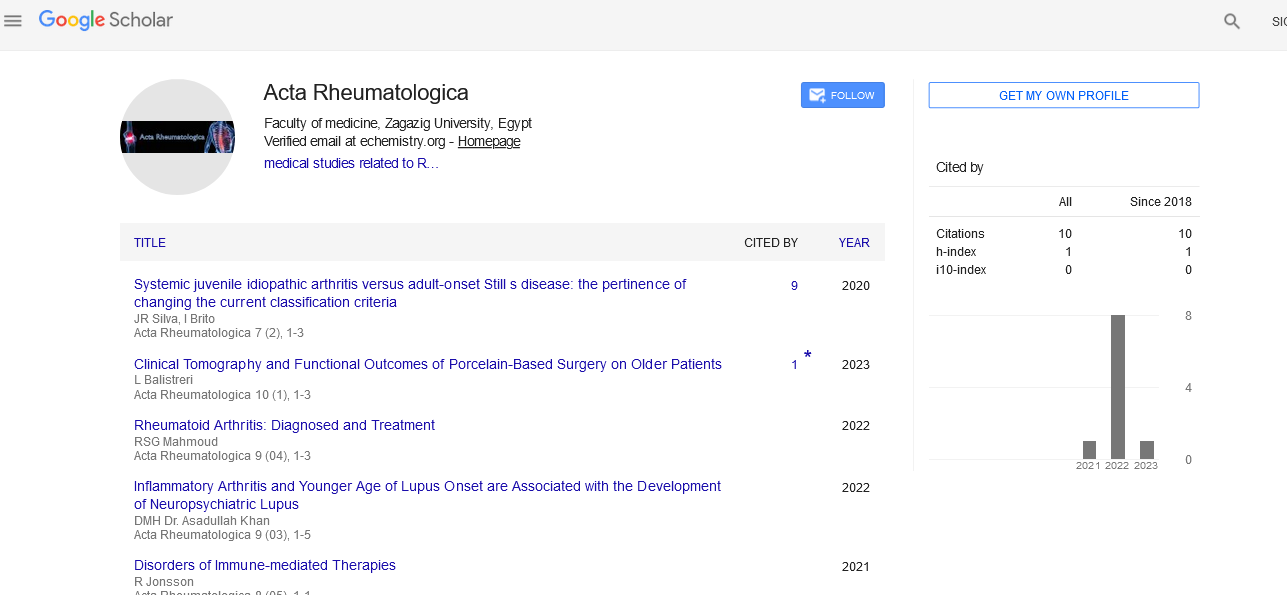Perspective - (2024) Volume 11, Issue 2
Navigating the Complexities of Chronic Knee Pain: A Comprehensive Guide to Diagnosis, Treatment, and Management
Claire Bombardier*
Department of Rheumatology, University of Calgary, Calgary, Canada
*Correspondence:
Claire Bombardier, Department of Rheumatology, University of Calgary, Calgary,
Canada,
Email:
Received: 03-Mar-2024, Manuscript No. IPAR-24-14673;
Editor assigned: 05-Mar-2024, Pre QC No. IPAR-24-14673 (PQ);
Reviewed: 20-Mar-2024, QC No. IPAR-24-14673;
Revised: 28-Mar-2024, Manuscript No. IPAR-24-14673 (R);
Published:
04-Apr-2024
Introduction
Chronic knee pain is a pervasive condition that affects millions
of individuals worldwide, often leading to significant impairment
in mobility, function, and quality of life. From degenerative joint
disease to inflammatory arthritis and traumatic injuries, the
causes of chronic knee pain are diverse and multifactorial. In this
in-depth article, we embark on a journey through the
complexities of chronic knee pain, exploring its underlying
mechanisms, diagnostic challenges, treatment options, and
strategies for long-term management.
Description
Understanding chronic knee pain: Unraveling the
underlying mechanisms
Chronic knee pain can arise from a variety of underlying
conditions, each characterized by distinct pathophysiological
mechanisms. Osteoarthritis, the most common cause of chronic
knee pain in older adults, is characterized by progressive
degeneration of the articular cartilage, leading to joint
inflammation, pain, and stiffness. Inflammatory arthritis, such as
rheumatoid arthritis or psoriatic arthritis, involves an
autoimmune response that targets the synovium, causing joint
inflammation and damage. Traumatic injuries, such as ligament
tears or meniscal tears, can result in chronic knee pain due to
altered joint mechanics and persistent tissue damage.
Diagnostic challenges: Navigating the road to diagnosis
Diagnosing the underlying cause of chronic knee pain can be
challenging, as it often requires a comprehensive evaluation that
includes a detailed medical history, physical examination, and
diagnostic imaging studies. Imaging modalities such as X-rays,
Magnetic Resonance Imaging (MRI), and Computed Tomography
(CT) scans may be used to visualize the knee joint and assess for
structural abnormalities such as cartilage loss, bone spurs, or
ligamentous injuries. Laboratory tests, including blood tests and
joint fluid analysis, may also be helpful in identifying
inflammatory or autoimmune conditions that can contribute to
chronic knee pain.
Treatment options: From conservative measures to
surgical intervention
The management of chronic knee pain is multifaceted and
may involve a combination of conservative measures,
pharmacological interventions, physical therapy, and surgical
procedures. Non-pharmacological treatments, such as weight
management, exercise therapy, and physical modalities like ice
or heat application, can help reduce pain and improve joint
function. Pharmacological interventions, including Non-steroidal
Anti-Inflammatory Drugs (NSAIDs), corticosteroid injections, and
hyaluronic acid injections, may provide symptomatic relief by
reducing inflammation and improving joint lubrication. In cases
of severe or refractory pain, surgical interventions such as
arthroscopic debridement, joint replacement surgery, or
ligament reconstruction may be considered to address
underlying structural abnormalities and restore joint function.
Lifestyle modifications an d self-management
strategies
In addition to medical interventions, lifestyle modifications
and self-management strategies play a crucial role in managing
chronic knee pain and improving overall quality of life.
Maintaining a healthy weight through diet and exercise can help
reduce stress on the knee joint and alleviate pain symptoms.
Low-impact activities such as swimming, cycling, or yoga can
improve joint flexibility, strengthen supporting muscles, and
promote overall joint health. Using assistive devices such as
knee braces, orthotic inserts, or walking aids can help reduce
joint stress and improve mobility in individuals with chronic knee
pain.
Psychosocial factors and coping strategies
Psychosocial factors, including stress, anxiety, and depression,
can significantly impact the experience of chronic knee pain and
the effectiveness of treatment interventions. Addressing these
factors through cognitive-behavioral therapy, mindfulness-based
stress reduction, or other psychosocial interventions can help
individuals better cope with pain and improve their overall wellbeing. Supportive social networks, peer support groups, and patient
education programs can also play a valuable role in providing
emotional support, sharing coping strategies, and promoting
self-efficacy in managing chronic knee pain.
Future directions in chronic knee pain management
As our understanding of the underlying mechanisms of
chronic knee pain continues to evolve, so too do our treatment
approaches and management strategies. Emerging therapies
such as regenerative medicine techniques, including Platelet-
Rich Plasma (PRP) therapy and stem cell injections, hold promise
for promoting tissue repair and regeneration in damaged knee
joints. Advances in biomechanics, personalized medicine, and
precision rehabilitation are also shaping the future of chronic
knee pain management, with a focus on optimizing treatment
outcomes and improving long-term prognosis for affected
individuals.
Conclusion
Empowering patients, enhancing quality of life. Chronic knee
pain is a complex and challenging condition that requires a
comprehensive and multidisciplinary approach to diagnosis,
treatment, and management. By addressing the underlying
causes of pain, implementing evidence-based interventions, and
empowering patients to take an active role in their care,
healthcare providers can help individuals with chronic knee pain
achieve better pain control, improved function, and enhanced
quality of life. Through ongoing research, education, and
collaboration, we can continue to advance the field of chronic
knee pain management and improve outcomes for patients
affected by this debilitating condition.
Citation: Bombardier C (2024) Navigating the Complexities of Chronic Knee Pain: A Comprehensive Guide to Diagnosis, Treatment, and Management. Acta Rheuma Vol:11 No:2





